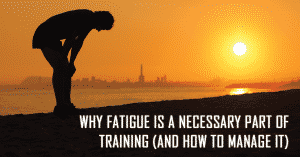 Simply running 26.2 miles is a daunting task, so the thought of trying to race a full marathon as fast as you can seems almost impossible – and probably a little crazy. It’s no surprise then that training for a marathon is as much a mental battle as it as a physical one.
Simply running 26.2 miles is a daunting task, so the thought of trying to race a full marathon as fast as you can seems almost impossible – and probably a little crazy. It’s no surprise then that training for a marathon is as much a mental battle as it as a physical one.
During each workout and long run, most runners can’t help but think to themselves : “there’s no way I could continue running this pace for 26.2 miles.”
Many beginners think this is a fear unique to their inexperience, but take it from someone who’s logged upwards of 140 miles per week, if your goal is to race hard and push your limits, marathon pace for 26.2 miles is hard to wrap your head around.
The secret is, you should almost never feel like you could run a full marathon at goal pace in training. If you do, it’s likely your goal is far too easy.
In this article, we’ll delve into exactly why you shouldn’t feel like you could maintain goal pace for 26 miles in training. Hopefully, understanding some of the science and physiological principles behind this fact will give you confidence and help you train intelligently.
Accumulative fatigue
One of the most important concepts to remember about training is that an individual run or workout does not occur in a vacuum. The stress and tiredness from your previous workouts impacts your performance on a particular day. This accumulation of stress and tiredness is what coaches call accumulative fatigue.
Accumulative fatigue is a critical component of proper marathon training, so it’s not a bad thing. Accumulative fatigue enables you to practice running with low glycogen levels and simulate running on tired legs. In fact, a solid marathon training plan will often specifically try to make you tired before your important workouts and long runs.
The problem many runners face during marathon training is that it’s difficult to quantify accumulative fatigue. Unless you’re extremely sore or tired heading into a workout, it’s something that is easy to forget. Just because you feel fresh heading into a run doesn’t mean your previous training runs have no impact on your upcoming workout. By design, you should be tired.
However, on race day you’ll be fully tapered and rested. Unlike your long runs and workouts, you won’t have a 40-90 mile week in your legs and you won’t have tired yourself out from a killer, long workout just a few days before. While this rested feeling can’t be quantified, it is very significant to how you’ll perform on race day compared to regular workouts.
A helpful trick to help you factor in accumulative fatigue is to think of your workouts and long runs starting at the distance you left off at the previous day.
For example, if you ran a total of eight miles on Saturday, with a portion of that being at steady or marathon pace, you’d be starting Sunday’s long run at mile 8. Therefore, the last miles of your 18 mile long run on Sunday would actually be miles 8 through 26.
Glycogen stores
Related to accumulative fatigue is that training for a marathon continuously depletes your glycogen stores, which means you won’t start every workout or long run fully fueled. As a result, you’re likely to experience the effects of running on low glycogen, which results in decreased physical and mental performance (yes, your brain needs glycogen too).
For example, when your body starts to run low on carbohydrates, it will attempt to use fat as a fuel source. This is good in training, as it will improve your ability to burn fat as a fuel source during the race, but from a performance perspective, you can expect to see about 15 percent decrease in performance when running at your aerobic threshold (roughly marathon pace) when burning fat as opposed to glycogen. Obviously, this 15 percent reduction in performance is going to make your workouts harder than they would feel on race day.
On race day, you’ll be fully fueled and your glycogen stores will be at capacity. Not only will you have reduced training in the three to five days pre-race, but you’ll have consciously topped off your glycogen stores.
In addition, you’ll have ample opportunities to refuel during the race. Very few runners take in as many calories during training as they do races. Partially, this is due to availability since you can only carry or stash so much fluid and snacks. Regardless, you’ll likely be taking in more calories during a race than any single training session and thus delaying glycogen depletion.
Adrenaline and support
Finally, it’s important to recognize the positive impact adrenaline and competition have on performance.
You probably realize that it’s nearly impossible to run a 5k or 1 mile PR in practice (if you have strong PRs at these distances). When racing, you’re able to take your performance to a level impossible to reach on your own.
While you can’t put a number on it, adrenaline and competition will make the race distance feel two-thirds of what it really is.
The next time you start thinking about how you couldn’t possibly run another 10 miles at marathon pace during a workout or long run, remember these important concepts of marathon training and relax. Marathon training is supposed to feel this way and if it doesn’t, you’re not preparing yourself properly!
RunnersConnect Bonus
Download your FREE Long Run and Aerobic Pacing Calculator now.
Need help converting your race times to your optimal easy and long run pace? Download our FREE calculator and we’ll do the math for you.





13 Responses
Wow! This was just what I needed to read this week before my half marathon. Of course it all makes sense, but I had never thought of it like this before. Thank you Jeff!
Thank you so much coach Jeff! I’m running the Copenhagen marathon tomorrow, and I was very unsure if to go for 3.19.59… Now if confident that its within my reach! Thank you thank you thank you
/Sara, Malmoe, Sweden
Finished at 3:20:56, top 10% total. 51th woman, 14th in my age category (w40).
Wow, great race and glad you went for it. That’s a great time and fantastic finish.
Wow – I think this EVERY TIME I run! Like it’s impossible.
I just ran a long run yesterday and finished the last half pretty fast simply because I wanted to see if I could hit MP at the end of my long run. Sarah Crouch reminded me that there is a place in the training plans for fast finish long runs but not for every single long run. It is not a good idea. This article really backs that up because I do often find myself wondering how in the world I am going to hit my marathon goal running the pace I am running in my long runs. I especially like how you presented the idea of accumulative fatigue.
Interesting article, the adrenaline part is spot on. When I run my first half, the finishing part of it was just positive crazy. I just started accelerating so much to the point that I only run this pace on my 5 k race , and this time I had 20k packed in my legs running against the wind. So , yes this is real, race is a race and training is a training where I will not experience the adrenaline boost.
ps. thank you jeff for your articles, they are really useful.
Lightbulb moment! Ding!
Well we are honored that we were the trigger for that! Hopefully now you see you are not alone!
great stuff Accra Milo marathon is coming on 21/09/15 am ready to run
Good luck!
Finally I’ve found the answer I’ve been looking for. I’ve googled this many times to no avail then I came across this article. Almost every time I run I think to myself, “there is no way I can keep up this pace for my race distance”. I’ve always wondered if other runners thought the same. And I’ve come to the conclusion that come race day you can keep that pace.
Glad you enjoyed Michael, we would love if you shared with family and friends, most marathon runners struggle with this, and you never know who you may reach!